

Wally Explains Dine' and What it means for traditional Navajo People. Japanese Mythology: 5 Legends and Ancient Myths and Legends. Do you have a fascination with old Japanese myths and legends?

Japanese mythology is full of epic tales of adventure along with deep reflections on life. Learning about Japanese history and culture is also a great idea for those studying the language. A little bit of background before we dive into the myths: Japanese mythology consists of stories derived from old folk beliefs and incorporates elements of Shinto mythology as well as Buddhism. Passed down from generations through both spoken word and writing, there is a vast number of ancient tales that touch upon virtually every aspect of life. Common themes in Japanese mythology are deities, royalty, and nature. Japanese Mythology: 5 Famous Japanese Legends 1.
The creation myth comes from the Kojiki, or “Record of Ancient Matters,” the first book written in Japan (dating back to 712) and the Nihon Shoki (finished in 720). The story begins in a limitless, formless chaos of a dark, silent universe. 2. Izanagi is too late. 3. Japan - Demographic trends. Japan’s population distribution is highly variable. The mountainous character of the country has caused the population to concentrate within the limited plains and lowlands—notably along the Pacific littoral.
The increased population there, however, was absorbed into the expanding urban areas, while the population of rural districts declined considerably; this had the effect of further concentrating population in a limited area. Japan experienced spectacular population growth after 1868; the population increased nearly fourfold since then. This increase was directly related to slow but steady urban growth; the development of Hokkaido, Tōhoku, and southern Kyushu; and the introduction of commercial agriculture. Japan population.
Japan: Government >> globalEDGE: Your source for Global Business Knowledge. SPICE - Japanese Religions. Paul WattOctober 2003available in PDF format ( 114.22 KB Contents Shinto Buddhism Confucianism Christianity and the New Religions Notes The Japanese religious tradition is made up of several major components, including Shinto, Japan’s earliest religion, Buddhism, and Confucianism.
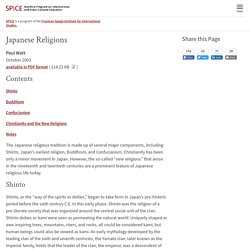
Shinto Shinto, or the “way of the spirits or deities,” began to take form in Japan’s pre-historic period before the sixth century C.E. Since early Shinto did not have a founder or produce sacred texts, it was through communal rituals that the religion was transmitted. Although Shinto had no sacred structures in its earliest phase, by the sixth and seventh centuries C.E., the Japanese began to build shrines that housed symbolic representations of the kami and that provided a site for rituals. (1) Buddhism. Japan. Egypt — The World Factbook. Details - Egypt - Seasons & Climate. Egyptian civilization - Myths - Creation myth. Like other creation myths, Egypt's is complex and offers several versions of how the world unfolded.
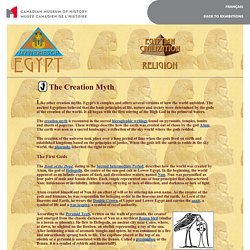
Egypt Country Profile - National Geographic Kids. Ancient Egyptian Religion. Learning Objective Describe the religious beliefs and practices of Ancient Egypt Key Points The religion of Ancient Egypt lasted for more than 3,000 years, and was polytheistic, meaning there were a multitude of deities, who were believed to reside within and control the forces of nature.Formal religious practice centered on the pharaoh, or ruler, of Egypt, who was believed to be divine, and acted as intermediary between the people and the gods.

His role was to sustain the gods so that they could maintain order in the universe.The Egyptian universe centered on Ma’at, which has several meanings in English, including truth, justice and order. Our Egypt. Talking about Egypt is talking about the sun.
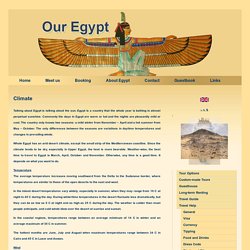
Egypt is a country that the whole year is bathing in almost perpetual sunshine. Commonly the days in Egypt are warm or hot and the nights are pleasantly mild or cool. The country only knows two seasons: a mild winter from November – April and a hot summer from May – October. Ancient Egyptian religion. Ancient Egyptian religion, indigenous beliefs of ancient Egypt from predynastic times (4th millennium bce) to the disappearance of the traditional culture in the first centuries ce.
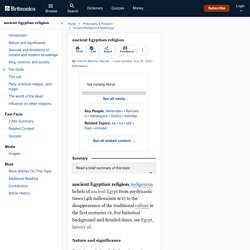
For historical background and detailed dates, see Egypt, history of. Britannica Quiz Destination Africa: Fact or Fiction? The largest country in Africa is Algeria. Egyptian religious beliefs and practices were closely integrated into Egyptian society of the historical period (from c. 3000 bce). Ancient Egyptian Government. The government of ancient Egypt was a theocratic monarchy as the king ruled by a mandate from the gods, initially was seen as an intermediary between human beings and the divine, and was supposed to represent the gods' will through the laws passed and policies approved.
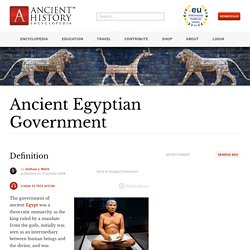
A central government in Egypt is evident by c. 3150 BCE when King Narmer unified the country, but some form of government existed prior to this date. The Scorpion Kings of the Predynastic Period in Egypt (c. 6000-3150 BCE) obviously had a form of monarchial government, but exactly how it operated is not known. Egyptologists of the 19th century CE divided the country's history into periods in order to clarify and manage their field of study. Periods in which there was a strong central government are called 'kingdoms' while those in which there was disunity or no central government are called 'intermediate periods.' Egypt's form of government lasted, with little modification, from c. 3150 BCE to 30 BCE.
Legacy.